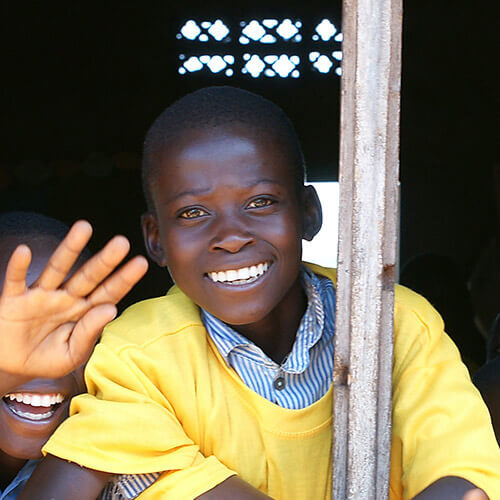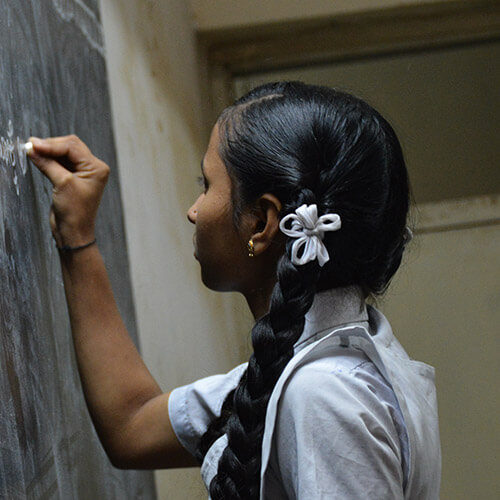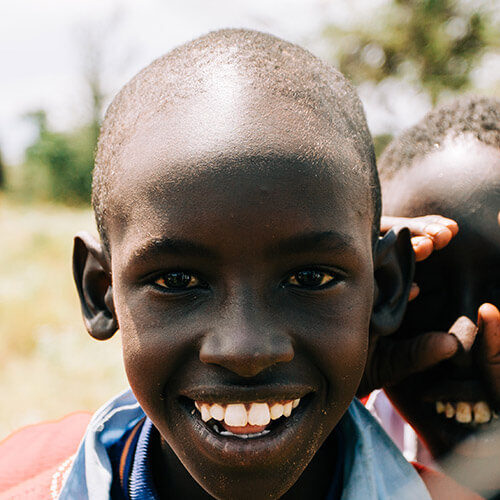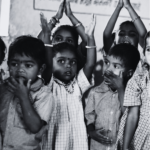Meal planning:
We began to first understand challenges to delivering safe nutrition to children across the country. These challenges became our benchmarks to designing a powerful and impactful Nutrition Model. The macro- indicators pointed at Water, Sanitation, Poverty and Illiteracy as primary causes. These were further compounded by reasons such as gender discrimination, distances and lack of safe facilities.
As we dug deeper, it became clear that Children in India, especially newborns, their mothers and developing children did not have receive essential micro nutrients which were critical to mothers, the first thousand days of a child’s life and through their development years till age 6.
As per the Recommended Dietary Allowances by the Indian Council of Medical Research, infants below 12 months of age need atleast 80 Kcals of energy per day while children from age 1 to 6 need upto 1350 Kcals of energy per day.

Along with macronutrients such as protein, Carbohydrates and Fats, it was critical to their growth that they also get small quantities of essential micronutrients such as Calcium, Iron, Zinc, Magnesium along with a range of key vitamins. 80% of a child’s brain develops by the age of 2 years and these micronutrients are key to ensuring that the child develops adequate cognitive abilities.
DESIGNING THE FOOD SOLUTION
From our visits to urban and Rural areas of with High Burden of Malnutrition, it had become increasingly clear that apart from unsafe cooking practices, children did not have access to micronutrients which were critical to their wholesome growth and development.
Thus each challenge identified became a parameter for us to hone solution. Our Food solution had to be:
- Nutritious: Each meal for children had to be Energy Dense and fulfill at least half of their daily macro and micro-nutrient requirement.
- Relevant: The meals had to be commonly relatable fun and tasty for children in order to gain their acceptance which was key to success of the model. The ingredients used would have to be locally available and commonly used for them to be accepted.
- Easy to Transport and Store: Since 70% of Indians live in the rural area, we needed to design meals which could be delivered across small and large distances to places with difficult access. Our food solution had to be designed to have a long shelf life with easy transport and storage requirements. Refrigeration was not a solution.
- Food Safety: Since we were focused on children, we had to ensure that we would not use any artificial flavoring agents or preservatives. The meal preparation at Anganwadi centers or communities would have to be done with minimal handling or contact.
- Easy to Prepare On site: From experience, we knew that meals once prepared or cooked increase in safety and hygiene risks when transported over long distanced. It was important that the meals were easily prepared on site with minimal skill requirement by community members in villages and urban centers.
- Security and Wastage: Since distribution would be across large areas with several collaborative partners, we would need to ensure security through easy tracking and tracing of meals.
- Community Driven: We recognized that our model had to be Community driven to ensure reach and sustainability. Integrating communities to become a part of the solution would bring a sense of involvement and responsibility, increase livelihood opportunities and bring in behavior change for the long term. Thus, the solution needed to account for diversity and accessibility to everyone through educed complexity.
MILESTONE APPROACH
We identified that Ready to Cook Food mixes would be an apt methodology to meet the challenges we encountered. Ready to Cook Food mixes are partially cooked and processed foods where ingredients are mixed in pre-defined ratios to achieve optimal nutrition, consistency and required taste. This was an important milestone as it provided for a Fit to Purpose solution for the India Situation.
This methodology offered:
- Long Shelf Life at Room Temperature: Ready to Cook Food Mixes are prepared in a way that the use of natural preservatives and partial cooking allows for the shelf life of the Food Mix to be at least 60 days when stored at Room temperature. This mean that Food mixes could be easily transported and stored anywhere without any preservatives or refrigeration.
- Just Add Water: The Food mixes could be prepared on site by any one by just adding water and heat which also meant that Food delivery risks had been reduced tremendously while bringing in the possibility of easy replication of the process for rapid expansion to needy areas. A few pots and pans, a stove and a lockable cupbaord which are easily available would be enough to meet the security challenges.
THE MENU
While we had identified a working methodology, we still had to create meals that were relatable, energy dense, safe and had adequate fortification to meet the beneficiary’s nutrition needs. We spent more time with urban and rural communities to understand their eating habits and preferences.
Rice was identified as a staple diet which was also easily available across locations. We noticed the use of Sattu which are prepared by roasting grains or grams were easily accepted by adults and children alike. Locally available and amply grown ingredients such as peanuts and jaggery which were rich in protein and iron were also preferred by communities everywhere. This gave birth to a menu mix largely consisting of Rice and grain based Khichdis and Sattu based Ladoos. The khichdis could be prepared on ground and offered the macro nutrients and satiety value while the Ladoos enjoyed by children and could be packed with micronutrients.
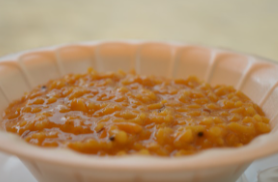

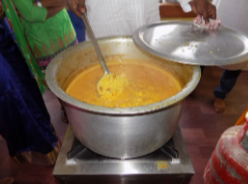
HUGGI FOR CHILREN AND ADULTS
The Huggi in Karnataka, Pongal in Tamil Nadu, Pulagam in Andhra Pradesh is known more popularly as the Khichdi across the country. This combination of rice and lentils cooked together is the ultimate comfort food and rich in carbohydrates and energy.
We developed a wide variety of Ready to Cook Khichdis such as Dalkhichdi, Daliya Khichdi and even the Soya Khichdi to which we added peanuts and chunks of Soya to increase it’s protein content. Every 250 gm bowl of power packed Khichdi provided about 250 Kcals of energy.
A detailed test of the food mix with NABL accredited Labs indicated that the Food mix had a shelf life of 60 days. Distributed in Multi-layered Metallic pouches, the entire process of making a Khichdi was contactless, One had to just cut the pack and pour the contents straight into the cooking vessel and cook with water to prepare it in short while.
ROUNDING THE LADOO
We suspected that nutritious Sattus which were widely accepted would be a solution as they could be consumed without cooking and could serve as a base for a variety of added ingredients and nutritional ingredients. The resulting Food mix mix could be based on Sattus made from grams, wheat, rice or even Ragi which is very high in protein.

To ensure the micronutrient needs were fulfilled, we added a Combination of Minerals and Vitamins (CMV mix) in powder form which was tasteless and easily blended with the Sattus and a little sugar.
Our first approach was to serve this mix as a hot drink with water as a nutritious drink to children but we learned that this was not fun and the children began to reject the hot drink. The food design team found a festive answer to the challenge.
Ladoos are traditionally eaten in India during celebrations and hugely enjoyed by adults and children. We wondered if these spheres of happiness could lead the way to the heart of children. It was a versatile option that could be prepared with Jaggery, dryfruits and a variety of Sattus such as Wheat, Soya and even Ragi.
The earlier created food mixes were rolled into Ladoos and received a huge welcome from the children in rural and urban centers. These could be prepared without any cooking just by adding a little water to form the shape.
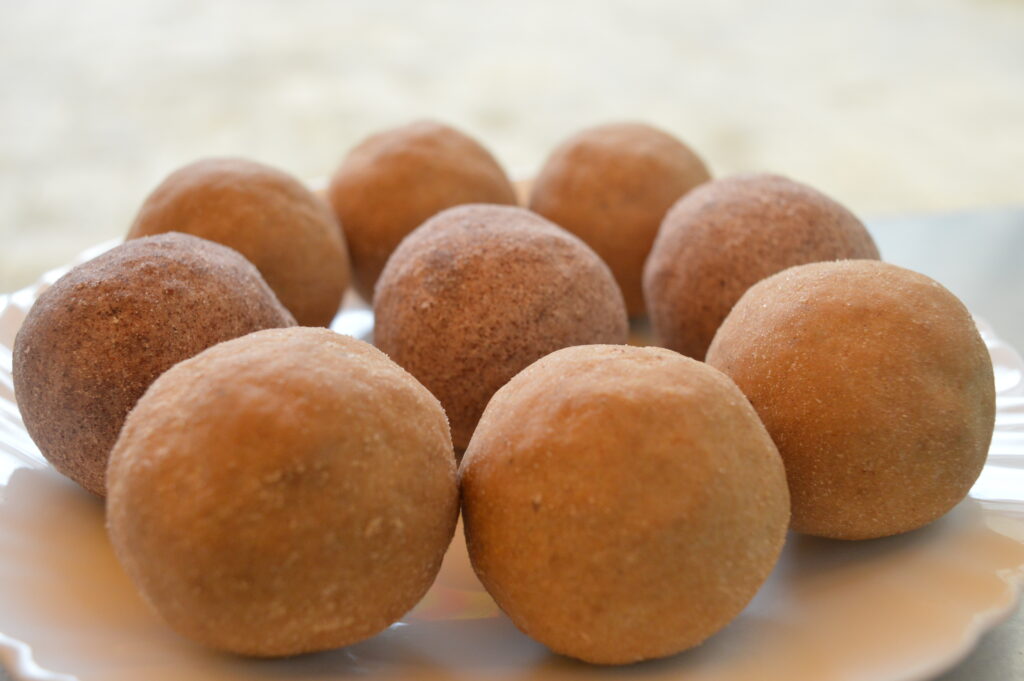
A small Ladoo of just 40gms provided a child with over ~235 Kcals or energy along with a bouquet of vitamins and minerals which would be beneficial to their growth. These Ladoos were also given to pregnant and Lactating mothers to improve their nutrition levels. The labs told us that this Food Mix too had a shelf life of 60 plus days at room temperature.
FORMIDABLE UPGRADES
We were always aware that the strongly odoured Cyanobacteria known as Spirulina was a treasure box of nutrition that had to be opened. The World Health Organisation declared Superfood is highly rich in protein, has upto 18 Amino acids and 96 trace elements with 25 times more calcium and 4 times more iron. Further, Spirulina helps to increase the absorption of the gut this increasing the assimilation of necessary nutrients.
We turned to the quintessential jaggery, which offered a high amount if iron while serving as a base for the Food Mix. To further mask the strong and pungent flavor of Spirulina, we added coconut and even cocoa powder.
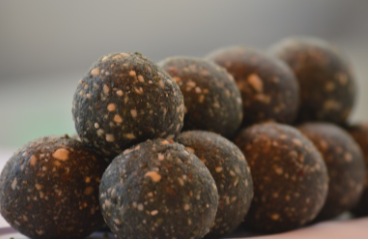
The Spirulina based Super Ladoos could be given in smaller quantities of just 25 gms and yet, the beneficiary would receive ~135 Kcals with a strong mix of micronutrients. When we tested in Jawhar, the project received a huge welcome and was quickly scaled to serve 10,000 + beneficiaries across 163 anganwadis in 6 Beats of Jawhar.
So far, we have developed of 30 plus varieties of Ready to Cook, Energy dense and nutritious Food Mixes and utilized them to nourish over 1,70,000 beneficiaries across locations as diverse as Andhra Pradesh, Haryana, Maharashtra and Madhya Pradesh.


